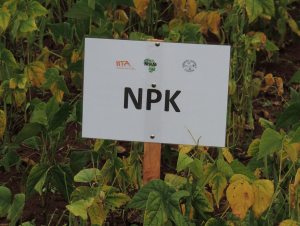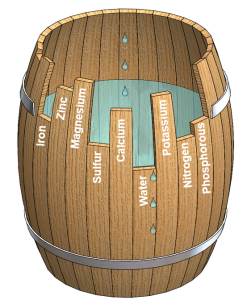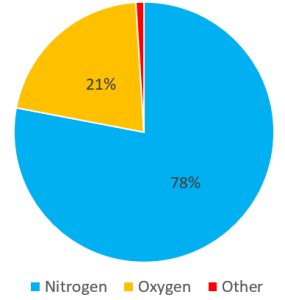5.5 Identifying Limiting Nutrients
Dawn Hart
Learning Objectives
By the end of this section, you will be able to do the following:
- Identify the most common limiting nutrients in plants.
- Connect nitrogen to plant growing processes.
- Describe how Liebig’s barrel represents a metaphor to explain the “law of the minimum.”
Common Nutrient Limitations in Plants
As we have seen in the previous chapter section, a limitation of certain nutrients can have negative consequences for plant growth. Some of these nutrient limitations may inhibit the plant’s ability to synthesize certain macromolecules (i.e., carbohydrates, lipids, proteins, and nucleic acids). All macromolecules have a basic requirement for carbon, hydrogen, and oxygen. Some macromolecules have additional requirements. For example, nitrogen is needed to synthesize proteins and nucleic acids while phosphorus is needed to synthesize nucleic acids and some lipids (i.e., phospholipids). Chlorophyll is an important pigment molecule in plants that is needed in the light harnessing step of photosynthesis and requires both nitrogen and magnesium. Rubisco is an important protein enzyme needed in the carbon fixation step of the Calvin cycle which also requires a lot of nitrogen. Some nutrients are required to run important processes in plants, as opposed to, being important as components of macro-molecular building blocks. For example, potassium is needed to support the creation of ion gradients which help drive many important processes like water uptake in the roots as well as opening and closing of stomata which is important in controlling gas exchange between plants and their environment. While there are many nutrients needed by plants to serve as building blocks and performing important processes, there are three in particular that are usually the most commonly limiting. These most commonly limiting nutrients are often found as the main ingredients in commercially sold fertilizers: nitrogen, phosphorus, and potassium (N-P-K) (Figure 5.5.1).

The Role of Nitrogen
Nitrogen is a very important element needed by plants as a major component of chlorophyll, proteins, and nucleic acids. Without enough nitrogen, plants would have a difficult time harnessing light energy, fixing CO2 from the atmosphere to create sugars, catalyzing biochemical reactions, growing and dividing new cells, and synthesizing new proteins. Ironically, although the most abundant gas in our atmosphere is nitrogen gas (Figure 5.5.2), this form of nitrogen is not accessible to most plants (for an exception to this, see N-fixing plants in the next section of the textbook “three sisters garden”). The triple bond found between two nitrogen atoms in N2 gas is very difficult for plants to break. This results in the N2 gas of the atmosphere being virtually unavailable to plants. Since plants need to absorb nitrogen from the soil (generally in the form of nitrate and nitrite) and not the air, it is important for soil nitrogen levels to remain at a high enough level to maintain plant health and growth. Unfortunately, many agricultural growing practices end up depleting the soil over time which can greatly reduce crop yields. The invention of chemically synthesized nitrogen fertilizers has had a major impact on our ability to grow food crops and revolutionized agricultural production capabilities. Now, human activities are primarily responsible for the conversion of inorganic nitrogen into forms that can be absorbed by plants.
Figure 5.5.2. Percent gas composition of air. [Image description]
Liebig’s Law of the Minimum
The history of the invention of plant fertilizers is complex with contributions from many individuals throughout the years. One of the early contributors was Justus von Liebig (1803–1873), a German chemist. Liebig has been considered one of the principle founders of organic chemistry and “father of the fertilizer industry.” At the young age of 13, he lived through a global famine which arose following an extremely harsh winter climactic event in 1816. The famine destroyed most food crops in the northern hemisphere; Germany was especially hard hit. This influential event in Liebig’s formative years is thought to have influenced his later interest in studying plant nutrition. One of the notable contributions he made was in describing the “law of the minimum,” which states that plant growth will be limited by the nutrient in the shortest supply and not by the total amount of resources available. The law of the minimum has frequently been depicted using the metaphor of “Liebig’s barrel” (Figure 5.5.3). The metaphor uses a barrel in which the level of water represents the growth of a plant. If the water level increases, this represents growth of the plant and vise versa for a decrease in the water level. The staves (or planks) that make up the barrel are different heights and they represent the nutrients available to the plant. The shortest plank on the barrel would be the nutrient in shortest supply and therefore would be the limiting nutrient. The plant (i.e., water level) will only be able to increase in growth when more of the limiting nutrient is supplied. The addition of any of the other nutrients would have no impact on growth as they are not the ones limiting the growth. In the barrel analogy shown in Figure 5.5.3, water is the shortest plank, the limiting nutrient, and only providing water would be able the increase the water height in the barrel (i.e., make the plant grow).

Practice Questions
Limiting Nutrients: Algal Growth in a Freshwater Lake
A group of biology students is studying algal growth in a freshwater lake to determine which nutrient limits productivity of the system. They measure the percent composition of nitrogen (N) and phosphorus (P) in the lake water and in algal tissue collected from the lake.
| Location / Component | % Nitrogen (N) | % Phosphorus (P) |
| Lake water (dissolved available pool) | 0.10% | 0.005% |
| Algal tissue (average tissue composition) | 6.00% | 0.69% |
-
Treatment A — control (no nutrients added)
-
Treatment B — add nitrogen (N) only
-
Treatment C — add phosphorus (P) only
Walk through:
Treatment A: the control group within a trial is the negative control, we anticipate no change.
Treatment B: since we predicted that nitrogen is not the limiting nutrient, adding more of it will not result in additional growth. If our hypothesis is correct, we predict no change.
Treatment C: adding the limiting nutrient removes the constraint from the algal growth. We expect a large increase.
Glossary
Liebig’s law of the minimum
plant growth will be limited by the nutrient in the shortest supply and not by the total amount of resources available
Figure Descriptions
Figure 5.5.1. Close up on a sign that reads “NPK” in a field of plants that are yellowing. [Return to Figure 5.5.1]
Figure 5.5.2. Pie chart representing the composition of the atmosphere. Nitrogen represented in blue makes up 78% of the atmosphere. Oxygen represented in yellow makes up 21% while other gases make up the rest (shown in red) [Return to Figure 5.5.2]
Figure 5.5.3. An open wooden barrel is shown from above, partly filled with blue water. The barrel’s vertical slats are cut to different heights, and each is labeled with a resource name; water droplets fall in from above, yet the water level inside can rise only to the height of the shortest slat, visually explaining Liebig’s “Law of the Minimum,” that yield is limited by the scarcest resource. Transcribed labels (around the barrel, left to right): Iron; Zinc; Magnesium; Sulfur; Calcium; Water (shortest slat); Potassium; Nitrogen; Phosphorous. [Return to Figure 5.5.3]
Media Attributions
- NPK sign © IITA is licensed under a CC BY-NC-SA (Attribution NonCommercial ShareAlike) license
- air composition © Dawn Hart is licensed under a CC BY-NC (Attribution NonCommercial) license
- Liebig’s barrel © Steve Tamasi is licensed under a CC BY-NC (Attribution NonCommercial) license

